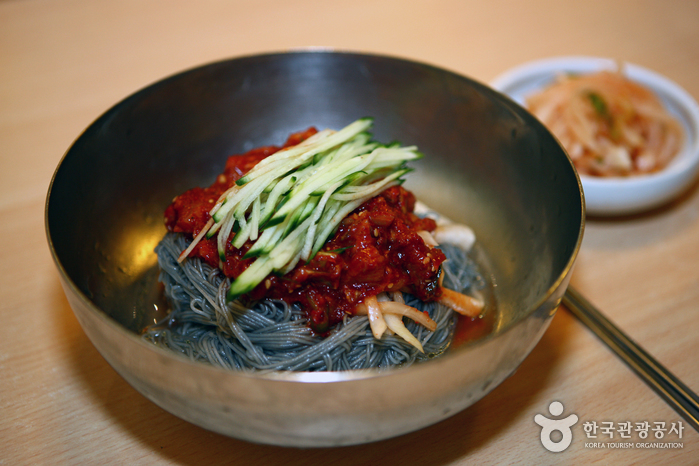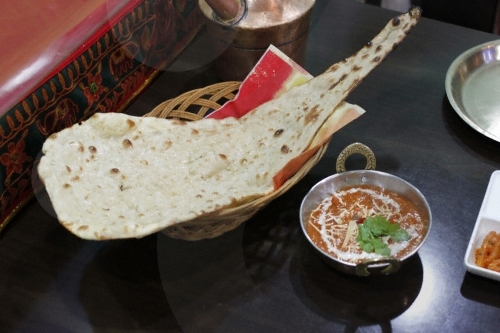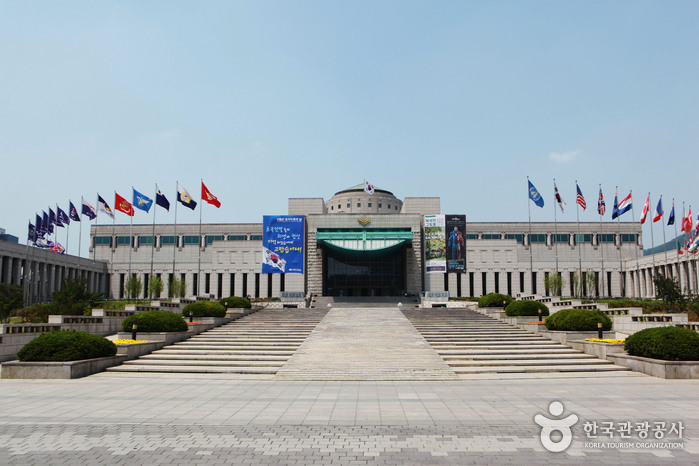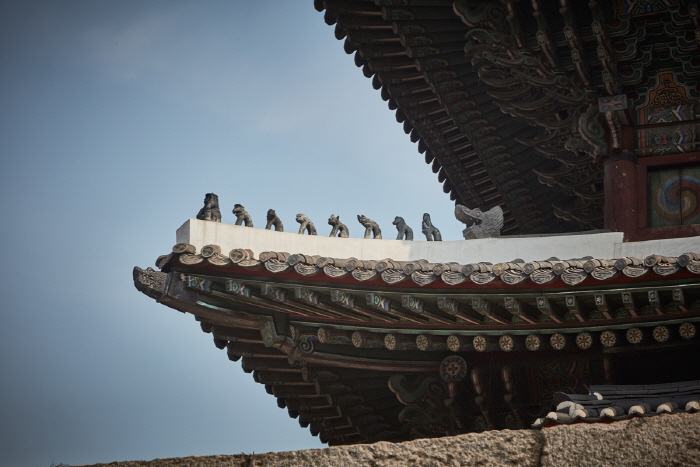KGC - Chungmu-ro Branch [Tax Refund Shop] (KGC 충무로점)
7.7Km 2024-04-16
235, Toegye-ro, Jung-gu, Seoul
-
Ojang-dong Hamheung Naengmyeon (오장동 함흥냉면)
7.7Km 2024-02-22
108 Mareunnae-ro, Jung-gu, Seoul
Ojang-dong Hamheung Naengmyeon originated when grandma Han Hyesun, who migrated from Hamgyeongnam-do to Seoul during the Korean War, began selling Hamheung-style "nongma guksu (starch noodles)," eventually naming it Hamheung naengmyeon (Hamheung cold buckwheat noodles). Its signature dish, bibim naengmyeon (spicy buckwheat noodles), features chewy noodles infused with a tangy-sweet seasoning, showcasing the expertise behind its preparation. Alongside the flavorful broth served as a base, the menu also includes variations like hoe naengmyeon (cold buckwheat noodles with raw fish), mul laengmyeon (cold buckwheat noodles), suyuk (boiled pork slices) and mandu.
Aritaum - Isu Branch [Tax Refund Shop] (아리따움 이수)
7.7Km 2024-04-22
1F, 25, Dongjak-daero 29-gil, Dongjak-gu, Seoul
-
Olive Young - Univ. of Seoul Branch [Tax Refund Shop] (올리브영 서울시립대)
7.7Km 2024-04-18
Store #104, #105, City Plaza, 222, Jeonnong-ro, Dongdaemun-gu, Seoul
-
Everest (에베레스트)
7.7Km 2019-09-02
2-1, Jong-ro 51ga-gil, Jongno-gu, Seoul
+82-2-766-8850
Nepal is located in the southcentral region of the Himalayan Mountains between India and Tibet, accounting for its diverse mixture of both country's cultures. Restaurant Everest allows guests to enter this culturally diverse world by offering cuisine from Nepal, India, and Tibet. In addition, Everest is operated by a Nepali owner, serving affordable food to tourists and students interested in the culture of Nepal. Customers can learn of the traditional food and culture of Nepal while listening to Nepali music and watching movies. The restaurant also provides a seminar area for various meetings.
Olive Young - Chungmuro Station Branch [Tax Refund Shop] (올리브영 충무로역)
7.7Km 2024-04-18
222, Toegye-ro, Jung-gu, Seoul
-
The War Memorial of Korea (전쟁기념관)
7.7Km 2022-12-29
29, Itaewon-ro, Yongsan-gu, Seoul
+82-2-709-3144
The War Memorial of Korea, located in Yongsan-gu, Seoul, exhibits and preserves materials related to the Korean War and serves as a national moral educational venue. It was established on June 10, 1994 by the War Memorial Service Korea Society to commemorate the noble sacrifice of patriotic martyrs. The museum houses approximately 33,000 artifacts with about 10,000 on display at indoor and outdoor exhibitions. There are six separate indoor halls, including Expeditionary Forces Room, Patriotic Memorial Room, War History Room, 6·25 Korean War Room, Development Hall and Large Machinery Room. The outdoor exhibition showcases large-sized weapons. Visitors of all ages from children to adults can also participate in 20 various educational programs and diverse cultural events such as military music and honor guard events, drawing contest, cultural event and more. The character of War Memorial of Korea is ‘Mudori’ featuring a helmet symbolizing the protection of the nation and a bay leaf meaning peace.
Dongdaemun Bonga Gamasot Seolleongtang (동대문본가가마솥설렁탕)
7.7Km 2024-03-15
299-1 Jong-ro, Jongno-gu, Seoul
+82-2-741-1510
Dongdaemun Bonga Gamasot Seolleongtang is a seolleongtang (ox bone soup) restaurant located near Dongdaemun Fashion Market. The rich-tasting seolleongtang is boiled for 24 hours in a traditional cast-iron pot, using beef from ten different parts of the cow, and the process is visible from outside the restaurant. It is recommended to enjoy the seolleongtang wrapped in rice with a side of tangy radish kimchi. Yennal bulgogi (old-fashioned bulgogi) and yukhoe bibimbap (beef tartare bibimbap) made with Korean beef are also popular menu items.
Heunginjimun Gate - Dongdaemun Gate (흥인지문)
7.7Km 2024-10-10
288, Jong-ro, Jongno-gu, Seoul
+82-2-2148-1842
Heunginjimun Gate was built to protect Hanseongbu, which historically housed essential government facilities. Heunginjimun Gate was the gate on the east side of the outer wall of Seoul Fortress among eight gates. It is referred to as Dongdaemun Gate as well. The gate was constructed during King Taejo’s 5th year in 1396, remodeled during the reign of King Danjong in 1453, and was newly built in 1869 during the sixth year of King Gojong’s reign in 1869.
The gate features a hipped roof with five front and two side compartments on a two-storied building. The thin and weak bracket system supports the eaves and is excessively decorated, reflecting the construction features of the late Joseon period. Also, outside of the fortress is the half-circle-shaped Ongseong, a small wall, to protect the gate.
One of the unique factors of Heunginjimun Gate is that it is the only gate among Seoul’s eight to have Ongseong, further exhibiting the style of construction used during the late Joseon period.
Traditional Performance at The Korea House (한국의집 전통예술공연 KOREA 심청)
7.7Km 2024-08-16
10, Toegye-ro 36-gil, Jung-gu, Seoul
• 1330 Travel Hotline: +82-2-1330 (Korean, English, Japanese, Chinese) • For more info: +82-2-2266-9101~3
The Korea House has been a venue for traditional performing arts for more than 20 years, presenting various musical performances, court dances, and folk dances such as Pungmulnori (farmers’ percussion
performance), Talchum (mask dance), Pansori (a traditional narrative vocal performance), and Sinawi (an ensemble of eight traditional musical instruments).
At Korea House, visitors can discover the diverseness and richness of Korean music and art performance. Popular and nationally recognized intangible cultural asset holders such as An Sook Seon, Park Byeong Cheon, and Lee Chun Hui perform on the stage under director Jeong Jae Man.
![KGC - Chungmu-ro Branch [Tax Refund Shop] (KGC 충무로점)](http://tong.visitkorea.or.kr/cms/resource/71/2878671_image2_1.jpg)

![Aritaum - Isu Branch [Tax Refund Shop] (아리따움 이수)](http://tong.visitkorea.or.kr/cms/resource/26/2880026_image2_1.jpg)
![Olive Young - Univ. of Seoul Branch [Tax Refund Shop] (올리브영 서울시립대)](http://tong.visitkorea.or.kr/cms/resource/94/2889594_image2_1.jpg)

![Olive Young - Chungmuro Station Branch [Tax Refund Shop] (올리브영 충무로역)](http://tong.visitkorea.or.kr/cms/resource/68/2888868_image2_1.jpg)



 English
English
 한국어
한국어 日本語
日本語 中文(简体)
中文(简体) Deutsch
Deutsch Français
Français Español
Español Русский
Русский